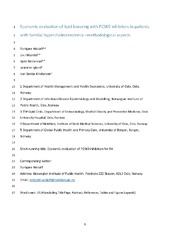Economic evaluation of lipid lowering with PCSK9 inhibitors in patients with familial hypercholesterolemia: Methodological aspects
Peer reviewed, Journal article
Accepted version
Permanent lenke
https://hdl.handle.net/1956/22769Utgivelsesdato
2019Metadata
Vis full innførselSamlinger
Originalversjon
https://doi.org/10.1016/j.atherosclerosis.2019.06.900Sammendrag
Background and aims: Proprotein convertase subtilisin/kexin type 9 (PCSK9) inhibitors have proved to reduce low density lipoprotein cholesterol levels in numerous clinical trials. In two large clinical trials, PCSK9 inhibitor treatment reduced the risk of cardiovascular disease. Our aim was to explore the impact of varying assumptions about clinical effectiveness on health and economic outcomes for patients with familial hypercholesterolemia. Methods: We used a previously published and validated Norwegian model for cardiovascular disease. The model was updated with recent data from the world's second largest registry of patients with genetically confirmed familial hypercholesterolemia. We performed analyses for 24 different subgroups of patients based on age, gender, statin tolerance and previous history of cardiovascular disease. Results: In 1 out of 24 subgroups, PCSK9 inhibitors were cost-effective when effectiveness was modelled using direct relative efficacy as reported in the FOURIER trial. When using assumptions, as suggested in a recent consensus statement from the European Atherosclerosis Society, 14 subgroups were cost-effective. Conclusions: Cost-effectiveness of PCSK9 inhibitors depends highly on assumptions regarding effectiveness. Basing assumptions only on randomised controlled trials, and not taking into account varying effects based on baseline cholesterol level, results in much fewer groups being cost-effective.

